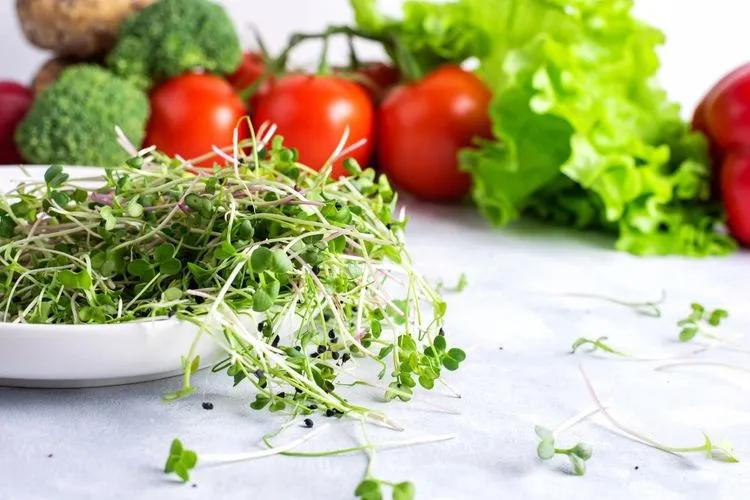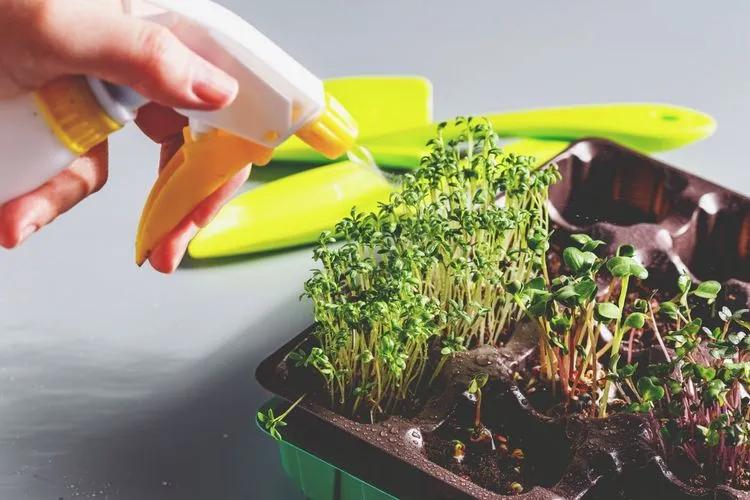
Microgreens are little green sprouts that you may have seen in restaurants, as decor for dishes, or in grocery stores on the shelf with organic products. They are easy to grow, delicious, and healthy. Have you ever wondered what microgreen is, how to grow it, and why? If so, stay with us because we will initiate you into the ranks of microgreen lovers.
Microgreen explained

Basically, microgreens are vegetable greens harvested just after the cotyledon leaves have developed, used mostly as a nutrition supplement. Microgreens belong to superfoods, plant products enriched with useful substances and microelements, which nutritionists recommend consuming as often as possible. Thus, they are not only tasty and pretty, but highly nutritious and useful for our bodies.
It will not be hard to recognize those beauties anywhere. These are sprouts of plants with three main parts: a central stem, a leaf, or cotyledon leaves (all of which are edible). Sprouts alter in size depending on the specific cultivated variety, with typical sizes ranging from 1 to 1.5 inches (from 25 to 38 mm) in total length. When these sizes are reached, they are harvested and used for their intended purpose. If you forget about your sprouts and do not cut them off in time, they won't be any longer considered microgreen.
Health benefits
During the first 10 days of microgreen life, the plants do not have time to accumulate harmful substances from the atmosphere, and sprouts live in ecologically clean conditions. Microgreen contains many phytonutrients (ascorbic acid, β-carotene, α-tocopherol, and phylloquinone) and minerals (Ca, Mg, Fe, Mn, Zn, Se, and Mo), compared with their mature-leaf counterparts. Microgreen helps cleanse the body, rejuvenates cells, and provides us with the necessary energy supply. With regular eating of microgreens, you can improve the functioning of the cardiovascular, digestive, nervous, reproductive, and endocrine systems.
According to the National Institutes of Health database, the availability of low potassium microgreens can be used to reduce potassium intake for the same serving of vegetables or to increase the amount of vegetable serving without excessively increasing potassium intake for patients with impaired kidney function.
History

Interestingly, the history of microgreen technology goes back to the 70s of the last century, when, with the increase in the duration of astronauts' stay in the Earth's orbit, the question of nutrition arose. Then people thought about the food that would contain a sufficient amount of necessary microelements and be light (after all, it is not cheap to deliver cargo to the Earth's orbit). After the cosmonauts tasted microgreen, this product became cosmically popular, and the cultivation technology spread throughout the world.
For growing microgreen at home, you'll need:

- Seeds, grains, legumes purchased from a store
- Containers with lids.
- Soil medium: hydroponics or ready-made soil.
- Illuminated place in the apartment (a windowsill is quite suitable if you want to grow a microgreen for yourself)
- Water sprayer
Put the moistened substrate in the containers that you have prepared for planting. Read the instructions on the seed packet carefully - sellers often describe how to grow that particular kind of microgreen. The seeds do not need urgent watering. It is enough to moisten them with a water spray afterward. Cover the containers with a lid, but not entirely, so that oxygen reaches your cuties. After a couple of days, the first sprouts will appear, then you can remove the lid and watch the growth of the microgreen. Having harvested, use it in salads, main dishes, or as a snack.
How to grow?
Growing a microgreen is as easy as shelling pears. The first step is to select the correct seeds. Since potatoes, tomatoes, pumpkin seeds, and beans, for example, cannot be grown, some of them may taste bitter or even be poisonous. Instead of them, you can plant the following species.
Sunflower
It contains many folic acids; therefore, it is recommended for pregnant women and women planning pregnancy. Sunflower sprouts normalize the work of the thyroid gland and cardiovascular system.
Alfalfa
It is crispy and fresh greens, like a freshly plucked cucumber from the garden. It is a smelly addition to fish, eggs, salads, and appetizers.
Amaranth
Greens with pink leaves that have a delicate taste with a nutty aftertaste. Great for making healthy smoothies.
Peas

Relieves swelling and normalizes kidney function due to its mild diuretic effect. It has a beneficial impact on immunity, fights against anemia and vascular, and heart diseases reduce the risk of blood clots.
Growing microgreens is easy, quick, and fun: moreover, they have a great nutritional value and can become a great source of minerals and vitamins for the whole family. So why not to try gain some health benefits from your home oasis?
